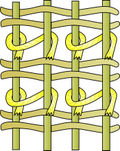A knotted-pile carpet is a carpet containing raised surfaces, or piles, from the cut off ends of knots woven between the warp and weft. The Ghiordes/Turkish knot and the Senneh/Persian knot, typical of Anatolian carpets and Persian carpets, are the two primary knots.[1] A flat or tapestry woven carpet, without pile, is a kilim. A pile carpet is influenced by width and number of warp and weft, pile height, knots used, and knot density.
"The structural weft threads alternate with supplementary weft that rises from the surface of the weave at a perpendicular angle. This supplementary weft is attached to the warp by one of three knots... to form the pile or nap of the carpet."[2] Knots are tied in rows, one to each pair of warp threads, which may then be pushed down to make the rug more solid: "the interwoven warp and weft threads form the carpet's foundation, and the design comes from the rows of knots."[3] "In the knotted-pile...the arrangement of rows of weft is the dominant consideration."[4]
Diagonal, or offset, knotting has knots in successive rows occupy alternate pairs of warps. This feature allows for changes from one half knot to the next, and creates diagonal pattern lines at different angles. It is sometimes found in Kurdish or Turkmen rugs, particularly in Yomuds. It is mostly tied symmetrically.[5]
- ^ Goswami, K.K.; ed. (2009). Advances in Carpet Manufacture, p.239. Woodhead Publishing in Textiles: Number 87 (The Textile Institute). ISBN 9781845695859. "The two most common types of knot used in an oriental carpet are the Persian knot and the Turkish knot."
- ^ Goswami (2009), p.220.
- ^ Rosemary Troy Krill (2010). Early American Decorative Arts, 1620-1860: A Handbook for Interpreters, p.248. Rowman Altamira. ISBN 9780759119468.
- ^ (1921). Tariff Information Surveys, p.15. U.S. Government Printing Office. [ISBN unspecified].
- ^ Cite error: The named reference
Eilland & Eilland Complete Guide 1998was invoked but never defined (see the help page).

